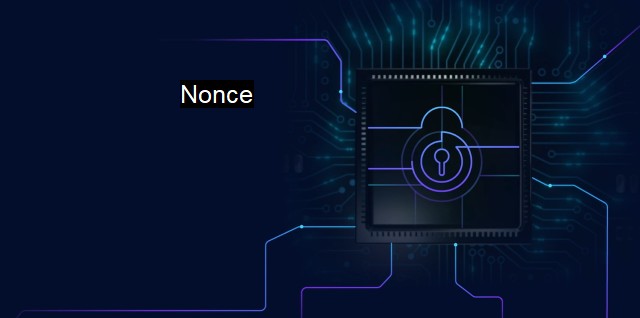What is Nonce?
Understanding the Importance of Nonces in Cybersecurity: A Key Element in Data Encryption and Digital Signatures
In cybersecurity and antivirus discussions, the term "Nonce" is frequently encountered. This term might sound obscure to individuals not acquainted with these technicalities, but it serves a central role in many aspects of cybersecurity and cryptography. Nonce is an abbreviation for "Number used Once," primarily in cryptographic communication. Its purpose is to guarantee the security and integrity of data, protect privacy, and prevent replay attacks by ensuring that each data packet or message is distinct.To fully understand what a nonce is and how it works, one must first grasp some aspects of cryptography. Cryptography is the science of protecting information by transforming it into an unreadable format. This technique is employed to protect sensitive details from unauthorized access or data interception. Cryptography plays a pivotal role in protecting data loyalty, confidentiality, and transaction authenticity. Nonce is an essential component of cryptography, particularly in hash functions and digital signatures.
A nonce is a random, typically arbitrary number or string of characters generated for a specific purpose, and used only once in a cryptographic communication. The idea here is to have a unique and unpredictable value that will prevent unauthorized parties from predicting or figuring out what the next nonce will be.
Nonces are indispensable in various cryptographic functions. they are a key feature of digital certificates in the Security Sockets Layer (SSL) and Transport Security Layer (TLS) protocols, where they're used during the handshake protocol. During this operation, the client and the server both generate random nonces, which helps establish a secure session without compromising the private encryption keys.
Consider how nonces operate in cryptographic hash functions. These functions transform input data into a fixed-size and seemingly random output. When a unique nonce is combined with this data, the hash function will yield a different result each time even when the input information remains unchanged.
In cryptocurrencies systems like Bitcoin, nonces are developed for another purpose. Namely, miners must solve complex mathematical puzzles to validate new transactions and add them to the blockchain. These puzzles often incorporate a nonce, which miners alter to achieve a desired hash result. Once they have found an appropriate nonce--signifying a solved puzzle--that value is then included as part of the new block on the blockchain.
Nonces are essential for fighting a cybersecurity vulnerability: replay attacks. This is a sort of network attack where an intruder intercepts a data transmission and fraudulently retransmits it. The concern raised by replay attacks is grounded in the fact that the retransmitted packet is indistinguishable from the original, "legitimate" data packet. Consequently, nonces are used to tackle this security issue by securing that each encrypted message, despite the content, is unique.
Nonces have minor drawbacks that should be noted. As the efficiency of a nonce not to be repeated relies on its algorithm quality, it is possible that a poorly designed nonce generation system could tentatively repeat nonces. This repetition has the potential to weaken a system's security defenses, particularly if nonces are heavily used within an encryption system.
a nonce is an elementary element yet it plays a substantial role in cybersecurity. Its significance lies in its capacity to enhance the security and integrity of various cryptographic processes, therefore making them less vulnerable to hacking and other forms of cyber-attacks. While the concept may appear niche, in actuality, it powers the secure transactions, information, and processes integral to much of the technological landscape. Reiterating the significance of investing in sound digital security is the essential lesson here.

Nonce FAQs
What is a nonce in cybersecurity and antivirus?
A nonce, in cybersecurity and antivirus, is a random number that is generated for a specific purpose. It is generally used to add an additional layer of security to a system by preventing replay attacks or tampering with data.How is nonce used in antivirus software?
In antivirus software, nonce can be used to verify the integrity of digital signatures or to prevent malware from evading detection by changing its code. It can be used as a part of the cryptographic process to ensure that the data has not been tampered with during transmission.Why is nonce important for cybersecurity?
Nonce is important for cybersecurity as it helps to secure data by adding an additional layer of randomness. Since a nonce is a random number, it cannot be predicted or replicated easily, making it difficult for hackers to launch an attack. It can also be used to prevent replay attacks, which is a common type of attack used by hackers to steal sensitive information.Can nonce be used for encryption and decryption?
Nonce can be used for encryption and decryption, as it can help to add randomness to the encryption process. This makes it more difficult for an attacker to crack the encrypted data. Nonce can also be used to protect the decryption process, by ensuring that the data has not been tampered with during transmission.| | A | | | B | | | C | | | D | | | E | | | F | | | G | | | H | | | I | | | J | | | K | | | L | | | M | |
| | N | | | O | | | P | | | Q | | | R | | | S | | | T | | | U | | | V | | | W | | | X | | | Y | | | Z | |
| | 1 | | | 2 | | | 3 | | | 4 | | | 7 | | | 8 | | |||||||